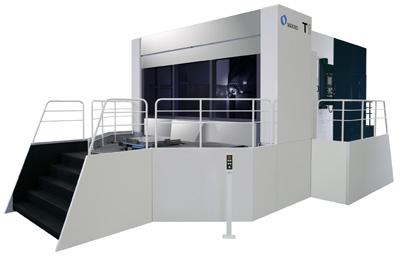
Makino introduces the T1 5-axis horizontal machining centerfor high-efficiency machining across a wide range of large part applications. The machine's rigid design, versatile cutting capabilities and sizable work envelope make it an ideal fit for industrial component manufacturing and aerospace job-shop environments, where machining of both soft and hard metals is required.
"The T1 5-axis machining center is designed to handle parts of any shape, in any material," says David Ward, horizontal machining center product line manager. "The T1's unique casting and kinematic structure provide ideal accessibility to large prismatic or cylindrical workpieces. The machine features a plus 45-degree to minus 110-degree A-axis tilting spindle, which, coupled with a deep chest column design, allows a minus 90-degree spindle centerline positioning to 550mm (21.6 inches) beyond pallet center. As a result, large workpieces that are 1-meter (3.2 feet) square by 500 to 800mm (19.6 inches to 31.4 inches) high can be machined in a single five-sided machining process. The value of the T1's operation consolidating 5-axis accessibility is compounded by its spindle capability. The torque and power of the 12,000-rpm spindle make it highly productive in the machining of non-ferrous, ferrous and hard-metal materials, putting shop owners in a unique position to deliver highly competitive machining solutions for workpieces of any shape and any material."
The T1 is ideal for large parts commonly machined in industrial, energy and aerospace industries, and it provides X-, Y- and Z-axis travels of 1,500mm (59.1 inches), 1,300mm (51.2 inches) and 2,000mm (78.7 inches), respectively. Workpiece limitations on the 1,000-mm (39.3 inches) pallets are 1,500mm (59.1 inches) in diameter by 1,500mm (59.1 inches) tall. Maximum pallet payload is 3,000 kg (6,600 lbs).
When producing large, heavy components, a machine tool should deliver the dynamic stiffness and rigidity critical to achieving the highest level of cutting stability. The construction of the T1 meets such requirements with thick Z-axis bed castings, wide slideway surfaces and a deep-chest, monolithic column design, supporting the X- and Y-axis. These features are enhanced with Makino's Active Damping technology that removes cutting vibrations from each axis. Together, these design considerations yield enhanced cutting stability, greater productivity and longer tool life.
The machine's B-axis rotary table offers a 360-degree rotational speed of 3,600 degrees per minute, which is supported by 10,000 Nm of continuous torque (29,000 Nm peak). The spindle tilting A-axis offers 6,300 Nm of continuous torque (20,000 Nm peak), and enhances spindle and workpiece accessibility with a compact 400-mm (15.7 inches) pivot distance.
Traditional approaches for 5-axis machining use trunnion tables for rotary motion. The T1 employs an alternate design with a unique A/B-axis configuration that eliminates the need to tilt the workpiece by shifting A-axis motion to the spindle side. This simple change in 5-axis kinematics delivers significant improvements over trunnion solutions. Operators also benefit from unobstructed visualization of the cutting zone and a reduced distance between floor and pallet top for simplified fixture and part handling.
Large, heavy workpieces oftentimes cause beam deflection to occur in traditional trunnion tables, which can result in inaccurate part positioning. The T1 removes this issue with its B-axis rotary table and robust bed casting to support the load stresses from large, heavy workpieces. Additionally, its unique A/B rotary axis configuration eliminates shifting mass deflections caused by tilting the workpiece, ensuring consistent accuracy regardless of rotary axis position.
For the premium aerospace job shop, the ability to respond to a wide range of workpiece materials should not mean multiple, partially utilized machining centers or compromised spindle performance. The T1 has been specifically developed with a unique direct-drive spindle capable of high-performance operation in a wide variety of materials. The T1 spindle is ready for the challenges of titanium and nickel-based alloys with 1,000 Nm (737 ft-lbs) of torque that is available from 20 rpm all the way to 1,000 rpm. Extending the high torque levels out to 1,000 rpm ensures that the T1 is ready to take advantage of future hard-metal tooling developments. The T1 is equally competent in aluminum with a top spindle speed of 12,000 rpm. Continuous power of 56 kW (75 HP) is maintained from 1,000 rpm to the maximum 12,000-rpm level. The T1 spindle uses the HSK-A100 spindle interface for superior rigidity and accuracy.
The high-volume nature of aluminum machining and high temperatures generated during titanium roughing present challenges for chip and coolant system designs. Considerations for these workpiece materials are inherent in the T1's systems. Key aspects include a high-pressure, high-volume through-spindle coolant system delivering up to 1,000 psi at 26 gallons per minute directly to the cutting tip. This system effectively eliminates heat from the cutting zone, extends perishable tool life and optimizes chip evacuation during heavy roughing operations. Twin coolant tanks each store 264 gallons of water-soluble coolant. Standard cyclonic filtration and coolant temperature controller ensure continuously available clean and thermally stable coolant. Large chip volumes are quickly and efficiently removed from the machine via twin internal hinge conveyors and a dual-layer lift-up chip conveyor, enabling heavy roughing operations without limitation or concern.
The T1 offers numerous capabilities for improved utilization and reductions in non-cut time. A 60-position automatic tool changer (137-position optional) and an automatic pallet changer ensure uninterrupted operation. The T1 may also be integrated with Makino'smmC2 (Makino Machining Complex), a highly flexible automatic pallet transfer and storage system which enables long periods of unattended operation. Because it uses the same 1,000-mm (39.3 inches) pallet design as the 4-axis Makino A100E, both the T1 and A100E can reside in the samemmC2 system. This identical design allows sharing of fixtures and workpieces between the machines to create a powerful 4- and 5-axis machining solution.
Contact Details
Related Glossary Terms
- alloys
alloys
Substances having metallic properties and being composed of two or more chemical elements of which at least one is a metal.
- centers
centers
Cone-shaped pins that support a workpiece by one or two ends during machining. The centers fit into holes drilled in the workpiece ends. Centers that turn with the workpiece are called “live” centers; those that do not are called “dead” centers.
- coolant
coolant
Fluid that reduces temperature buildup at the tool/workpiece interface during machining. Normally takes the form of a liquid such as soluble or chemical mixtures (semisynthetic, synthetic) but can be pressurized air or other gas. Because of water’s ability to absorb great quantities of heat, it is widely used as a coolant and vehicle for various cutting compounds, with the water-to-compound ratio varying with the machining task. See cutting fluid; semisynthetic cutting fluid; soluble-oil cutting fluid; synthetic cutting fluid.
- dynamic stiffness
dynamic stiffness
Measure of a machining system’s ability to dampen vibration from a forced input. If the dynamic stiffness of a system is not sufficient to dampen vibration, chatter occurs. See static stiffness; stiffness.
- fixture
fixture
Device, often made in-house, that holds a specific workpiece. See jig; modular fixturing.
- machining center
machining center
CNC machine tool capable of drilling, reaming, tapping, milling and boring. Normally comes with an automatic toolchanger. See automatic toolchanger.
- payload ( workload)
payload ( workload)
Maximum load that the robot can handle safely.
- stiffness
stiffness
1. Ability of a material or part to resist elastic deflection. 2. The rate of stress with respect to strain; the greater the stress required to produce a given strain, the stiffer the material is said to be. See dynamic stiffness; static stiffness.
- work envelope
work envelope
Cube, sphere, cylinder or other physical space within which the cutting tool is capable of reaching.

